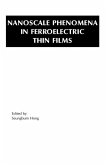Reconfigurable RF-frontends aim to cope with the continuous pursuit of wider frequency coverage, higher efficiency, further compactness and lower cost of ownership. They are expected to lay the foundations of future software defined or cognitive radios. As a potential enabling technology for the frontends, the tunable ferroelectric devices have shown not only enhanced performance but also new functionalities. This book explores the recent developments in the field. It provides a cross-sectional perspective on the interdisciplinary research. With attention to the devices based on ceramic thick-films and crystal thin-films, the book reviews the adapted technologies of material synthesis, film deposition and multilayer circuitry. Next, it highlights the original classes of thin-film ferroelectric devices, including stratified metal-insulator-metal varactors with suppression of acoustic resonance and programmable bi-stable high frequency capacitors. At the end the book analyzes how the frontends can be reformed by tunable multiband antennas, tunable single- and multiband impedance matching networks and tunable substrate integrated waveguide filters, which are all built on low cost ferroelectric thick-films. For all the above devices, the theoretical analyses, modeling and design methods are elaborated, while through demonstrative prototypes the application potential is evaluated.








